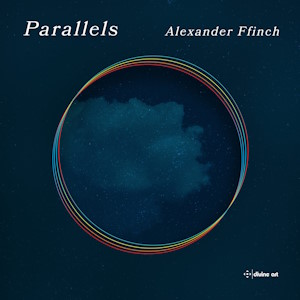
Parallels
Alexander Ffinch (organ)
rec. 2023, Cheltenham College Chapel, Cheltenham, UK
Divine Art DDX 21112 [68]
According to the Divine Art website, this disc recorded in Cheltenham College Chapel is a “meticulously curated album that explores the organ’s remarkable breadth and sonority. Featuring three monumental organ works and delightful arrangements of English classics, the collection is a testament to the grandeur and versatility of the instrument.”
Florence Price’s Suite No.1 shows none of the modernist traits of that time, no traces of Olivier Messiaen, Marcel Dupré or Jean Langlais. What she does bring to the party is an enthusiasm for certain African-American musical tropes: spirituals, hymns, pentatonic scales, and jazz-inspired harmonies and rhythms. After an ageless Fantasy, a Reger-style Fughetta takes the spiritual Sometimes I feel like a motherless Child as the subject. Jazz seems to infuse the Air, but only to a limited extent; this is no Gershwin exploring the genre. Perhaps Percy Whitlock was the model here? The concluding Toccato [!] certainly shifts along. It uses a “juba base” (juba dance was one of Price’s devices), which creates movement and makes it swing. There is a touch of the theatre organ here.
The rock band Coldplay is not on my radar. In 2011, they had a hit: Paradise from their fifth studio album Mylo Xyloto. Ten years later, Alexander Ffinch transcribed the song. I listened to the original track as part of my prep for this review. I can only say that the realisation for the organ reflects its “slice of hug-warm ecstasy”. If I heard this piece at the conclusion of Evensong, I would never guess its genesis and its fusion of “electronica, ambient, pop, R&B, classical and progressive rock”.
Little need be said about the Holst and Elgar transcriptions, always a pleasure to hear. It is especially appropriate to have Jupiter from The Planets to celebrate the 150th anniversary of Holst’s birth. Elgar’s Pomp and Circumstance No.1 might be considered a bit non-PC these days, but there is nothing controversial about his Chanson de Matin in Herbert Brewer’s 1904 arrangement.
I have not heard Dan Locklair’s music, at least not consciously. Peter Hardwick notes in The Diapason magazine that Rubrics is “one of the most frequently played organ works by an American composer”. Extracts were played at the Washington National Cathedral funeral service for President Ronald Reagan in 2004, and in the January 2009 Martin Luther King Jr. service at the Inauguration of President Barack Obama.
A Rubric (or Rubrick) in the Anglican Book of Common Prayer and successive revisions means an instruction to the officiant or worshipers. Locklair gave five directions. The energetic “The ancient praise-shout, ‘Hallelujah,’ has been restored…” is followed by a “Silence may be kept” which is a “lyrical movement featuring the flute stops.” Then there is a vivacious trumpet tune section which suggests “…and thanksgivings may follow.” Another slow, expressive, movement reflects on the instruction that “The Peace may be exchanged”. Rubrics concludes with the challenging toccata “The people respond – Amen!”. Overall, this satisfying work is jazzy and sometimes minimalistic, but still in the great tradition of 20th-century organ music.
Leon Boëllmann wrote Suite Gothique for the commissioning of the new Jean-Baptiste Ghys organ at Notre-Dame de Dijon. That was a small two-manual instrument, so the piece is suitable for a wide range of organs. The powerful Introduction-Choral, which contrasts a loud theme and its quieter echo, seems to run into the vigorous Menuet Gothique. The Prière à Notre-Dame evokes the statue of the Notre-Dame de Bon-Espoir. The final movement is the ever-popular Toccata with its surging progress that suggests both light and darkness. The soubriquet Gothique may refer to the literary genre, or more likely to the architectural structure of the Dijon church, a masterpiece of 13th-century Burgundy Gothic. The Suite gets an exceptional performance here.
The present three-manual and pedal organ at the Cheltenham College Chapel was originally built in 1897 by Norman and Beard. It was rebuilt by Harrison and Harrison in 1930, with additions in 1976. In 2013, a 32-foot Double Ophicleide pedal stop was added. The latest cleaning, re-leathering of the wind system and the restoration of the console and a new piston system were concluded in 2017. There is a complete specification of the current instrument in the booklet.
The liner notes (from which I quoted amply, with thanks) are by various hands. They are helpful, even if not all dates of composition or arrangement are given. There is Calvert Johnson’s lengthy essay on Florence Price, a long-winded interview between Alexander Ffinch and Dan Locklair, and notes on the other numbers. There is a resume of the soloist.
This is an impressive recital that ’parallels’ old and new favourites. New to me were Coldplay’s Paradise, Locklair’s Rubrics and Price’s Suite. It was good to hear Leon Boëllmann’s Suite Gothique and four pot-boiler English transcriptions.
John France
To gain a 10% discount, use the link below & the code musicweb10

Contents
Gustav Holst (1874-1934)
Jupiter, the Bringer of Jollity from The Planets op. 32 (1914-1917, arr. Thomas Trotter)
Florence Price (1887-1953)
Suite No.1 for Organ (1942)
Chris Martin (b. 1977)
Paradise (2011/2021, arr. Alexander Ffinch)
Edward Elgar (1857-1934)
Nimrod from Enigma Variations (1899/1932?, arr. William H. Harris)
Dan Locklair (b. 1949)
Rubrics (1988)
Edward Elgar
Pomp and Circumstance March No.1 (1901/1902, arr. Edwin H. Lemare)
Chanson de Matin (1899, arr. 1904, arr. Herbert Brewer)
Leon Boëllmann (1862-1897)
Suite Gothique, op.25 (1895)


















